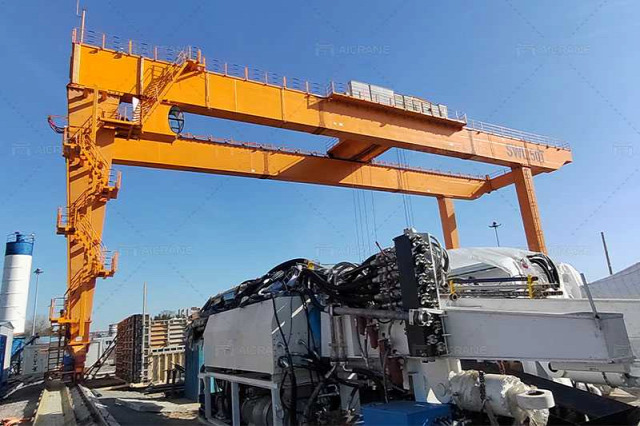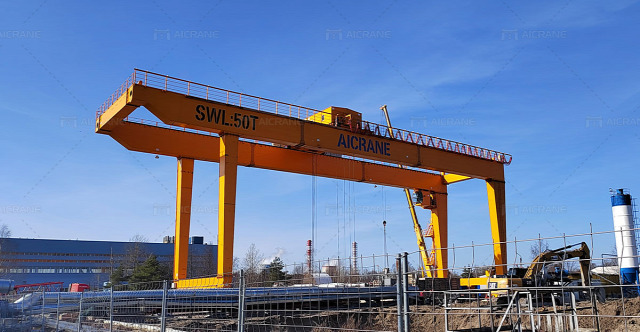Large-scale infrastructure projects, such as the construction of bridges, highways, power plants, and airports, are essential for economic growth and the development of modern societies. These projects require the mobilization of heavy materials, complex structures, and precision equipment to ensure successful completion. One of the most critical machines in these operations is the heavy-duty gantry crane. This versatile, robust equipment plays a key role in handling massive loads and supporting various stages of construction, from material transport to assembly. In this blog post, we will explore the significant contributions of heavy-duty gantry cranes to large-scale infrastructure projects, their benefits, types, and how they enhance efficiency and safety.
Why Heavy-Duty Gantry Cranes are Indispensable for Infrastructure Projects
In any infrastructure project, the lifting and transporting of heavy materials such as concrete blocks, steel beams, and precast components is a fundamental activity. Heavy duty gantry cranes are specially designed to handle these loads, with capacities ranging from 20 tons to several hundred tons. This makes them indispensable in environments where precision and power are critical to maintaining the project’s timeline and safety.
Some key advantages of using heavy-duty gantry cranes in infrastructure projects include:
- High Load Capacity: These cranes can lift extremely heavy materials, reducing the need for additional lifting equipment and minimizing delays.
- Versatility: Gantry cranes can be used in various environments, including construction sites, shipyards, factories, and railways. Their design allows them to handle a wide range of loads, from small to oversized items.
- Mobility: Many gantry cranes come equipped with rubber-tyred wheels, enabling them to move around the construction site with ease. This mobility is crucial for projects that require cranes to perform tasks at multiple locations.
- Precision: Modern gantry cranes are equipped with sophisticated control systems that ensure precise load handling, reducing the risk of damage to valuable materials and improving safety for workers.

Applications of Heavy-Duty Gantry Cranes in Infrastructure Projects
Heavy-duty gantry cranes are a versatile tool with a wide range of applications in large-scale infrastructure projects. Below are some of the most common uses:
1. Bridge Construction
One of the most prominent uses of heavy-duty gantry cranes is in bridge construction. When constructing a bridge, large precast beams and girders must be lifted into place with extreme precision. Heavy-duty gantry cranes, often mounted on rails, are used to move these beams from storage yards to the assembly points. In some cases, the cranes themselves are mounted on the bridge during construction to assist with lifting components.
For instance, during the construction of the Hong Kong-Zhuhai-Macao Bridge, massive gantry cranes were deployed to lift and position precast concrete sections that formed the bridge's structure. Without such heavy-duty equipment, the project would have been significantly delayed due to the complexity and weight of the components. To learn more about gantry crane applications, view the product page: https://aicraneliftingsolution.com/gantry-cranes/

2. Power Plant Construction
In power plant construction, heavy equipment such as turbines, boilers, and transformers need to be lifted and placed with millimeter-level precision. Heavy-duty gantry cranes, particularly double girder gantry cranes, are commonly used in this sector. They are instrumental in moving and assembling large parts during both the construction and maintenance phases of power plants.
For example, a 275-ton double girder overhead gantry crane was deployed at a power station construction site to lift and install massive components. Such cranes can handle the heavy, irregularly shaped loads that are typical in power generation projects.
3. Airport and Seaport Construction
The construction of large airports and seaports requires lifting and positioning vast amounts of steel structures, precast concrete, and other heavy materials. Heavy-duty gantry cranes can operate over large areas, making them ideal for these expansive sites. Their mobility and lifting capacity ensure that materials can be moved efficiently and safely, reducing downtime and improving overall project efficiency.
In seaport projects, gantry cranes are often used not just for construction but also for loading and unloading cargo. Rail-mounted gantry (RMG) cranes, for example, are used to lift shipping containers and transfer them between ships and storage areas. In the development of modern container terminals, heavy-duty gantry cranes are essential to create the infrastructure that supports global trade.
4. Dam and Tunnel Construction
Dams and tunnels are other large-scale infrastructure projects that heavily rely on the use of gantry cranes. These structures require the lifting of massive precast sections and other materials in tight, challenging environments. Heavy-duty gantry cranes, especially those with anti-sway technology, can operate in these confined spaces, delivering both power and precision.
For tunnel construction, a gantry crane might be used to lift and position concrete sections for tunnel linings, or to help remove waste material from the excavation. Their ability to handle complex and irregular loads makes them invaluable in this setting.
Types of Heavy-Duty Gantry Cranes Used in Infrastructure Projects
Heavy-duty gantry cranes come in a variety of designs, each tailored to specific types of projects. Here are a few key types commonly used in large-scale infrastructure work:
1. Double Girder Gantry Cranes
Double girder gantry cranes are built with two horizontal beams or girders, providing extra stability and capacity. They are commonly used in heavy lifting tasks such as bridge and power plant construction. The double girder design allows these cranes to handle larger spans and heavier loads, making them ideal for high-demand environments.
2. Rubber Tyred Gantry (RTG) Cranes
RTG cranes are mobile, rubber-tired cranes used extensively in projects that require flexibility and movement across large construction sites. They are typically seen in port and rail yard environments but can be adapted for infrastructure projects where lifting needs to occur over a broad area.
3. Rail-Mounted Gantry (RMG) Cranes
RMG cranes are commonly used in container handling but are also vital in infrastructure projects where fixed routes are needed. These cranes can be employed to lift and move large precast components for bridges and dams or during tunnel construction.
Benefits of Using Heavy-Duty Gantry Cranes in Large-Scale Infrastructure Projects
Using heavy-duty gantry cranes in large-scale infrastructure projects offers several key benefits, including:
- Increased Productivity: Heavy-duty gantry cranes can lift and move materials quickly, improving project timelines and overall efficiency.
- Improved Safety: With modern features like anti-sway technology, these cranes reduce the risk of accidents, making the construction site safer for workers.
- Cost Savings: By using fewer machines and reducing the need for manual labor, heavy-duty gantry cranes help lower overall project costs.
Conclusion
Heavy-duty gantry cranes play an essential role in large-scale infrastructure projects by providing the lifting power and precision necessary to handle massive loads. From bridge and dam construction to power plants and airports, these cranes enhance efficiency, improve safety, and contribute to the success of complex projects. As infrastructure demands continue to grow worldwide, heavy-duty gantry cranes will remain a cornerstone of modern construction, helping to build the structures that support our future.

